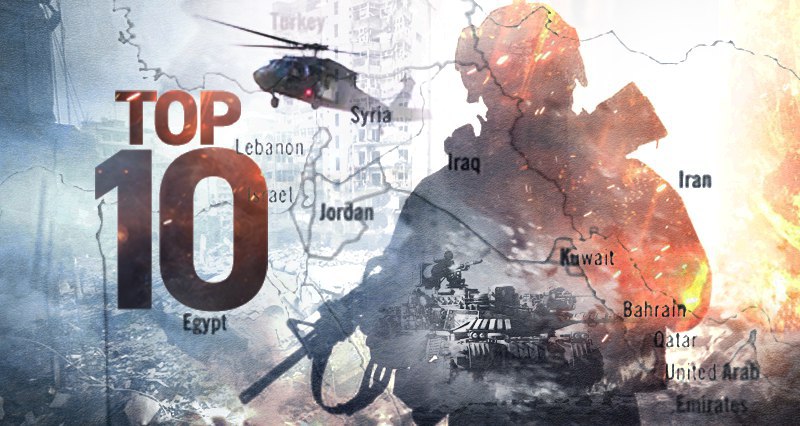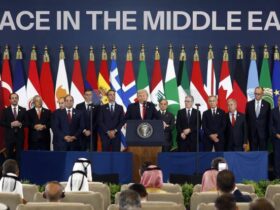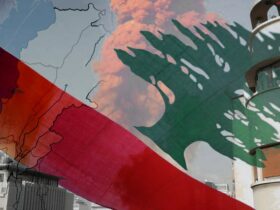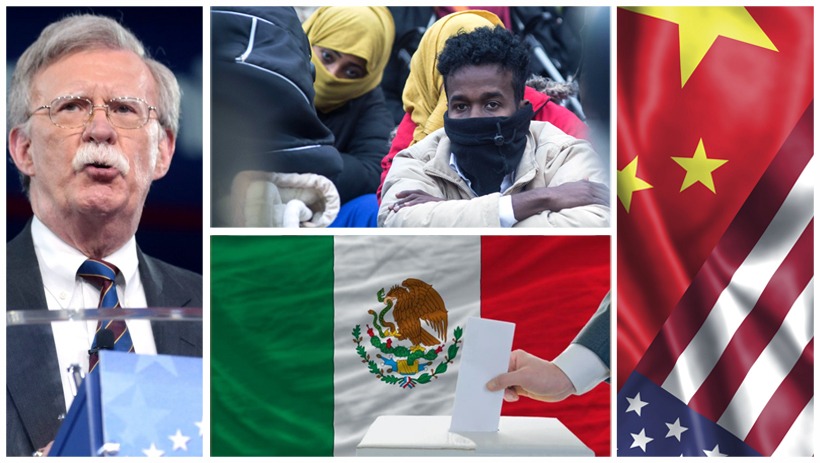Speech of Prof. Erenel in the conference on the Black Sea and The Eastern Mediterranean.
Speech of Prof. Erenel in the conference on the Black Sea and The Eastern Mediterranean.
The Center for National Strategy (USMER) has organized an international conference on the Eastern Mediterranean and the Black Sea on July 18 and 19 in Istanbul, Türkiye. Today, we present the speech of Prof. Dr. Fahri Erenel- Istinye University Faculty Member.
I express my deep respect for those who were mercilessly killed, who were made to suffer hunger under the false narrative of the Gaza Diet, and who lost their lives in Gaza, the West Bank, Syria, Lebanon, Yemen, and Iran due to the genocidal actions of Zionist Israel, the executor of US imperialism, which the German Chancellor acknowledged by remarking, “They do the dirty work for all of us.”
It is my belief that the conference, which examines the Eastern Mediterranean and the Black Sea from an integrated viewpoint and seeks to create a common understanding by perceiving these territories as a cohesive front, will provide insightful and enlightening outcomes.
We are referring to a region characterized by the continuous accumulation of energy, where these energies manifest in different degrees, and where the consequences linger for a considerable time on both regional and international levels.
In this region, we can identify all the elements of geostrategy, geoeconomics, and geoculture, ideas that shape and underpin the field of geopolitics.
The aspirations of what we might identify as the great powers of this period have invariably been directed towards this region. The Caucasus serves as a target, reminiscent of Hitler’s ambitions, or the quest for supremacy over the Eastern Mediterranean and the Middle East, as pursued by the US, UK, and France. Although the motivations propelling these powers to these territories may differ, the ones who bear the brunt are always the local populations and the region’s wealth. Presently, the Middle East and the Black Sea cannot be addressed without involving the United States. The power dynamics in the Black Sea and the Caucasus remain active. Countries within the European Union, particularly under Germany’s leadership, are executing strategic plans to amplify their influence in the region, especially in India and Mongolia. These strategies are consistent with the statement from the German Defense Minister: “Germany’s security begins in Tibet.”
As Mr. Alexander Dugin, who articulated his perspectives prior to my own, has highlighted, the entire region can only attain liberation if the West is expelled from it. The process of liberation will remain unfinished without the exit of the West. Every adverse circumstance currently present in the region reflects the influence of the West’s imperial aspirations.
Located at the center of Afro-Eurasia, which is often considered the world’s mainland, the Mediterranean Sea is identified as the largest inland sea on the planet, found at the center of a broad region that extends from the Strait of Gibraltar to the west and reaches the coasts of Turkey, Syria, Lebanon, Israel, and Egypt to the east. This sea is one of the most crucial water basins globally, a significance that has been acknowledged by all who have attempted to dominate this area throughout history. The Mediterranean’s positioning situates it at the globe’s center and, contrary to classical geopolitical theories, at the core of the world. In other terms, it establishes—especially the Eastern Mediterranean—the Heartland of the 21st century.
The Mediterranean Region serves as a geopolitical environment that has been molded and influenced by almost all the aspects highlighted by Suat İlhan in his text “Geopolitics.” This region has been, and continues to be, a point of interest for power centers both within and outside its confines.
In terms of geography and its influence, restricting the Mediterranean, and specifically the Eastern Mediterranean, to the Aegean Sea, the Middle East, North Africa, and Anatolia alone would yield an incomplete evaluation. The Eastern Mediterranean basin should be examined in conjunction with the Black Sea and its surrounding territories, the Caucasus and the Caspian Sea, as well as Western Asia.
Theories of geopolitics that focus on land, sea, and air often regard the Eastern Mediterranean and the Black Sea region as a singular whole. Mackinder’s Land Dominance Theory posits that the power that prevails in Eastern Europe will also control the area identified as the Heartland, which includes the Volga, Eastern Siberia, the Arctic Ocean, Iran, and Afghanistan. The power that dominates the Heartland will, in turn, dominate the World Island and, as a consequence, the world.
The geopolitical significance of the Eastern Mediterranean region is substantial. According to Mackinder’s theory of land sovereignty, the Eastern Mediterranean is the central hub of global maritime trade. Mahan’s theory of maritime sovereignty asserts that the Eastern Mediterranean, which lies between the trade routes of East and West and serves as the only access point to the world for the nations surrounding the Black Sea, is vital for global commerce. Long before Mahan, Barbaros Hayreddin Pasha expressed, “He who controls the seas controls world trade, and he who controls world trade controls the world.”
According to Douchet-Scitaklian’s air sovereignty theory, the Eastern Mediterranean serves as a platform for airborne intervention in the Balkans, the Middle East, the Caucasus, and the southeastern flank of the central region. Additionally, Spykman’s rim-belt theory suggests that the Eastern Mediterranean, by engaging with countries along the inner rim-crescent line, controls the rim-belt region. In Brezinski’s publication “The Grand Chessboard,” the world is metaphorically described as a vast chessboard, with Eurasia representing the most fertile areas of this chessboard.
Geopolitical theories essentially function as a roadmap for global powers, particularly the United States, in their imperial aspirations. These theories encompass a wider, integrative approach to the Eastern Mediterranean and Black Sea regions.
Given that strategic fault lines are mutually influential, any political or military maneuvers taking place in one or more of the Balkans, the Middle East, the Caucasus, the countries along the Black Sea, Southern and Eastern European nations, North African countries, the Turkish Republic of Northern Cyprus, the Greek Cypriot Administration of Southern Cyprus, or the Red Sea coastal nations within the hinterland of the Eastern Mediterranean basin will impact the entire region.
Recent occurrences in Syria, Lebanon, and Gaza exemplify this situation effectively. Thus, when analyzing the Eastern Mediterranean, considering the region merely as a maritime basin along with its coastal nations could result in significant errors in strategic decision-making.
The Mediterranean, in a more limited perspective, seems to be the geopolitical realm of around twenty countries. However, the Eastern Mediterranean, a land and sea basin bordered by superpowers like the United States, the European Union, the Russian Federation, China, and India, is recognized as one of the most geopolitically volatile regions globally, with its area of influence creating tension over a 7,000-square-kilometer zone. The Eastern Mediterranean basin, which is home to essential trade routes and a concentration of both underground and surface resources, is a critical area where strategic interests, particularly those related to energy, water, food, transportation, and logistics, can potentially lead to conflict.
In addition to the Eastern Mediterranean’s diverse strategic relevance—military, commercial, transportation, etc.—its expected high energy potential has naturally incited competition over resource distribution and, consequently, control of the seas.
When discussing the Eastern Mediterranean, it is vital to make a distinction between the Black Sea and its immediate environment. When viewed solely as a maritime basin, the Black Sea seems to consist of nations that border it. However, when considered as a land basin, a hinterland that includes the Balkans, the Middle East, the Caucasus, and North Africa becomes evident. Historically, these strategic focal points have drawn the interest of dominant actors wielding global or continental influence, who have sought to maintain authority over the region by projecting power into these areas. However, numerous fragile fault lines exist within the described hinterland, and on the edges of these fault lines lie conflict zones where strategic interests intersect.
The United States is the architect of the concept known as the Expanded Black Sea Region. Additionally, the US refers to the Black Sea region as a strategic gap. This viewpoint is rooted in the US’s instinct, as a global power, to project its influence to any part of the world at any time, thereby inhibiting the development of any formations outside its control from prospering.
It is a well-established fact that in all states characterized by a unitary structure, national elements are, in some manner, weakened and rendered ineffective. In contrast, the Expanded Black Sea Region has transformed into a substantial experimental ground for the US. It is possible to create various ethnic states and integrate them with the West. In this regard, the Black Sea region has significantly more hazardous and fragile fault lines compared to the Middle East, and the inability to contain any potential outbreak of conflict, along with the uncertainty of its outcomes, calls for a cautious approach to the concept of the Expanded Black Sea Region.
The Middle East, artificially segmented by the Sykes-Picot Agreement in 1916, has turned nearly intolerable after the fall of the Ottoman Empire. This division, often termed the “endless war,” has caused extensive bloodshed and anguish, especially among the peoples of the Middle East, and continues to this day. Global powers seek to manipulate the region, sometimes directly and at other times via their proxies. These proxies can be terrorist factions like ISIS, uprisings that are presented as the Arab Spring, or state entities such as Israel.
Today, the Middle East is poised to be presented with the second version of a new Sykes-Picot agreement. The borders are currently being redrawn. It would be extremely misleading to claim that this round of border redrawing will be confined to nations such as Iraq and Syria. The region is undergoing a comprehensive redesign. The events unfolding in Syria, the attack on Iran, and the potential for further fragmentation within the structure established by the US invasion of Iraq, Lebanon, and, of course, Gaza, highlight the plans for this division. In this second version, there will be no significant powers. The region will be shaped by structures that are nominally autonomous or federal, yet each will be under the control of a separate power. It can be said that the US’s Expanded Greater Middle East Project is being implemented step by step.
The Middle East is still regarded as one of the most strategically significant regions in the world in terms of energy. Rich in oil and natural gas resources, this area provides a major portion of the global energy supply. It is projected that by 2025, the demand for and competition over energy resources in the Middle East will further increase. The region’s essential infrastructure, including energy lines, pipelines, and maritime routes, leads to economic and political conflicts of interest among world powers. Furthermore, the existing religious, ethnic, and political divisions in the Middle East complicate this competition and are instrumental in shaping energy policies.
The Fertile Crescent, known for its fertile soil and often called the “cradle of civilization,” is found in the Middle East. This region benefits from relatively abundant water access, which allowed for the emergence of the earliest civilizations, including the Sumerians, in the Fertile Crescent. The Tigris and Euphrates Rivers regularly flood this area, while the Nile River also passes through certain sections. The rich lands surrounding these rivers have supported the growth of irrigation and agriculture. Despite the current challenges facing the Fertile Crescent, its identity as a cradle of civilization remains strong.
In addition, the Middle East and the Black Sea area are rich in various corridors and pathways, with the historic Silk Road being a prime example. Recent developments, such as China’s Belt and Road Initiative and India’s IMEC (International Economic Cooperation and Coordination Council), highlight the region’s potential for corridor development.
There has been a notable increase in refugee movements around the world recently. The key drivers behind these migrations are climate change, conflicts, and economic inequalities. The influence of these factors on global stability is anticipated to become more significant in the future. The Middle East, including Turkey, along with the rest of the world, is undergoing a substantial refugee and migration movement. In addition to the migration dilemma, two other pressing issues that all nations are grappling with are global warming and security threats.
Conclusion and Evaluation
In his publication “The New Middle Ages,” Alain Mine asserts that during the era he describes as “decay” or “collapse,” individuals became more isolated and individualized than ever. The terms decay or collapse denote a significant detachment from societal structures, resulting in heightened individualism. The New Middle Ages indicates a revival of a feudal system. This system is defined by loyalty, a lack of law, and a reign of fear. In such a framework, individuals often isolate themselves and shy away from collective movements. Autocratic leaders and feudal governments are notably present, with fear reigning supreme. The feudal system mirrors a mafia-like organization that is devoid of merit. National armies around the world, including that of the United States, are working towards a return to traditional military practices. The model of professional military service in national armies has its roots in medieval systems. The authority of the police has increased threefold, influenced by the prevailing rule of fear, localized governance, and centralized authority.
The nations of the Middle East and the Caucasus must urgently move beyond the New Middle Ages, a time characterized by decline or disintegration. Multipolarity represents their final opportunity to liberate themselves from the constraints imposed by the West. They should not chase after the illusory democracies introduced by Western powers, but instead, create authentic democracies that reflect the will of the people. It is essential for them to discover methods and resources to uplift their populations to the level of prosperity they rightfully deserve, thereby eliminating poverty and hopelessness. The term ‘Westernism,’ as employed by Western nations to signify their ineffectiveness, ought to serve as a cautionary tale for these countries. Rather than embracing a militaristic arms strategy that merely enriches Western nations, they should pivot towards Eurasia and assert their position on the global stage as equal and fully sovereign states.
In contrast, the field of geopolitics has recently begun to be heavily influenced by technological innovations. Aspects such as artificial intelligence, big data, cybersecurity, robotic technologies, and synthetic media are altering traditional geopolitical frameworks and turning the digital realm into a new sphere of geopolitics. Swift adaptation to the advancements required by the idea of geopolitics should also be a strategy for the countries in the Eastern Mediterranean basin to free themselves from their limitations.
While the previous order is disintegrating, the early signs of the new order are being experienced. The global political environment is in complete turmoil. Conflicts are ongoing on numerous fronts. The regions where these conflicts are concentrated include the Eastern Mediterranean and Black Sea basins. The developments shaped by the bloc-like tendencies of the United States and, subsequently, the Atlantic alliance are nearing their conclusion. On one hand, the United States and Europe are drifting apart; on the other hand, structural divisions are becoming evident within both the United States and Europe.

















Leave a Reply